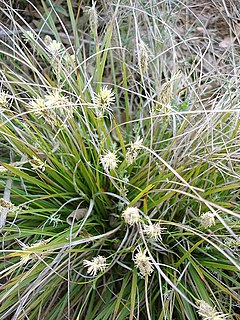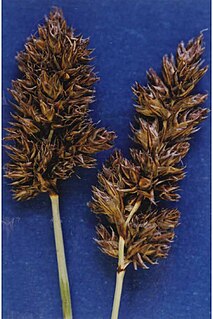
Carex is a vast genus of more than 2,000 species of grass-like plants in the family Cyperaceae, commonly known as sedges. Other members of the family Cyperaceae are also called sedges, however those of genus Carex may be called true sedges, and it is the most species-rich genus in the family. The study of Carex is known as caricology.

Carex jamesii, known as James's sedge or grass sedge, is a species of sedge native to North America from Minnesota east to New York and south to Oklahoma and South Carolina. It occurs in mesic hardwood forests and produces fruits from early May to mid July. It has two to four perigynia that are subtended by leaf-like pistillate scales. Its seeds are dispersed by ants.

Carex simulata is a species of sedge known by the common name analogue sedge.

Carex pensylvanica is a species of flowering plant in the sedge family commonly called Pennsylvania sedge. Other common names include early sedge, common oak sedge, and yellow sedge.

In botany, a perigynium, also referred to as a utricle, typically refers to a sac that surrounds the achene of plants in the genus Carex (Cyperaceae). The perigynium is a modified prophyll, tissue of leaf origin, that encloses the dry, one-seeded achene.
Carex klamathensis is a rare species of sedge known by the common name Klamath sedge. It is known from 15 or fewer populations in southern Oregon and three populations in the Klamath Region of northern California. It was described to science only in 2007. Its habitat includes fens and other wet habitat, on serpentine soils. It was discovered independently by botanists Peter Zika and Lawrence Janeway.

Carex lutea is a rare species of sedge known by the common names golden sedge and sulphur sedge. It is endemic to North Carolina, where it is known only from Pender and Onslow Counties in the Cape Fear River watershed. There are nine populations. The plant was discovered in 1991 and described to science as a new species in 1994, and it has not been thoroughly studied nor completely surveyed yet. Its rarity was obvious by 2002, however, when it was federally listed as an endangered species.

Carex inops is a species of sedge known as long-stolon sedge and western oak sedge. It is native to northern North America, where it occurs throughout the southern half of Canada and the western and central United States.

Carex distans, commonly known as distant sedge, is a plant species in the sedge family, Cyperaceae. It is native to Europe and North Africa. It is part of a complex of similar species that occur across Eurasia. Its relatives include Carex diluta of central Asia, which has also introduced to North America in Montana. Carex distans has been introduced to the US states including Maryland and Pennsylvania. More recently, it was found in Oregon. There is a report from Victoria, Australia as well.

Carex lacustris, known as lake sedge, is a tufted grass-like perennial of the sedge family (Cyperaceae), native to southern Canada and the northern United States. C. lacustris us an herbaceous surface-piercing plant that grows in water up to 50 cm (1.6 ft) deep, and grows 50–150 cm (1.6–4.9 ft) tall. It grows well in marshes and swampy woods of the boreal forest, along river and lake shores, in ditches, marshes, swamps, and other wetland habitat. It grows on muck, sedge peat, wet sand or silt, in filtered or full sunlight.

Carex bushii is a species of sedge in the genus Carex. It native to the eastern United States where it is found in areas of natural grassland.

Carex arctata, known as drooping woodland sedge, is a species of sedge native to eastern North America. It is sometimes called black sedge, compressed sedge, or drooping wood sedge. It occurs from Manitoba to the eastern seaboard in Canada, south to northwestern North Carolina, and west to Minnesota. Carex arctata grows in bogs, hardwood forests, and spruce forests.

Carex austrina, known as southern sedge, is a species of sedge endemic to the southern and central United States.

Carex eburnea, known as ivory sedge, ebony sedge, and bristleleaf or bristle-leaved sedge, is a small and slender sedge native to North America, from Alaska and Newfoundland south to central Mexico.

Carex blanda, the common woodland sedge or eastern woodland sedge, is a sedge native to a wide variety of habitats in the eastern and central United States and Canada.

Carex davisii, known as Davis' sedge or awned graceful sedge, is a species of Carex native to North America. It is listed as an endangered, threatened, or species of concern across much of edge of its range. It was named in the 1820s by Lewis David de Schweinitz and John Torrey in honor of Emerson Davis (1798–1866), a Massachusetts educator and "enthusiastic student of the genus" Carex.

Carex brevior, known as shortbeak sedge and plains oval sedge, is a species of sedge native to North America. The specific epithet brevior means "shorter" in Latin.

Carex glaucescens is a perennial sedge that belongs to the family Cyperaceae. The common name of this sedge is the southern waxy sedge due to the blue-grey, waxy appearance of the sheaths and fruits. The term "glaucous" means "gleaming" or "grey" in Latin; the specific epithet of C. glaucescens is derived from this term. Carex glaucescens is a native plant in North America and is an obligate wetland species in the Atlantic and Gulf Coastal Plains, Eastern Mountains and Piedmont, and the Great Plains.

Carex baileyi is a sedge in section Vesicariae the genus Carex native to the Appalachian mountains in Eastern North America. It is commonly called Bailey's sedge. Carex baileyi was named in honor of Liberty Hyde Bailey by its discoverer, Nathaniel_Lord_Britton.

Carex crinita, called fringed sedge, is a species of flowering plant in the genus Carex, native to central and eastern Canada and the central and eastern United States. It is the namesake of the Carex crinita species complex.


















